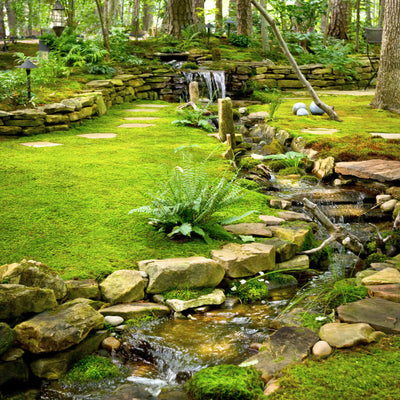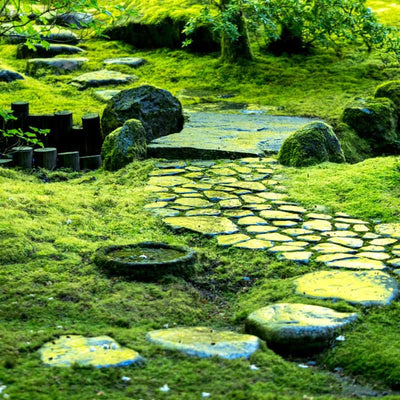Moss Beautifies Your Garden: A New Green Era
Moss might just be one of the most interesting plants that adds character to a garden. Out of the 12,000 types of moss, such as Cushion Moss (Leucobryum Glaucum), Sheet Moss (Hypnum Curvifolium), and Carpet Moss (Hypnum), they are still well-known for their ecological importance. They are mostly present in damp, shady spaces so they would be perfect for many gardens. Let’s be more specific on how moss can improve a garden in environmentally friendly, sustainable, and artistic ways.
Aesthetic and Conservation: A Balanced Approach
Mosses have a vital importance in garden conservation. They also reduce the demand for watering and fertilizing. Mosses have a unique ability to survive with less water than the average plant so they can be used to reduce water in a garden. This minimizes the use of water and fertilizers, and as such prevents them from seeping into the ground which can be detrimental to groundwater and the plant life present.
Moss gardens also provide an abundant supply of evergreen ground cover which is important in promoting a healthy balanced garden. Thus, in your garden, you are not just endorsing conservation but also promoting ecological sustainable living which is ideal for a garden.
Moss Helps Reduce Air Pollution Like an Air Filter
An interesting fact about moss is that it can purify the air. One type of moss that can do this is sheet moss. Like a sponge, it can soak up air pollution like sulfur dioxide, carbon monoxide, nitrogen oxides, and chlorofluorocarbons, also known as CFCs. All of these pollutants come from cars and factories that do a great deal of damage to the air and environment.
Anytime you place moss in your garden, you are improving the air quality and even lowering pollution. Plus, moss does not have to be mowed at all, unlike grass lawns which have to be mowed and destroyed by gas mowers that make the air even more dirty. A moss lawn, on the other hand, will help you save time, decrease your carbon footprint, and even make the air in your neighborhood much cleaner.
Adjusting humidity levels: A Self-Regulating System
Moss is able to thrive in and maintain humidity levels between 40 and 60% in an environment such as indoors or any wet location. For most living organisms in nature, these levels of humidity are relatively acceptable.
During dry periods, the moss absorbs the moisture in the air and normally lets some of it go when the humidity in the air is too high. Correcting and managing the humidity in a household is a plus for any homeowner. Fluctuating humidity is associated with dry skin, and the spread of viruses. For the owners that are experiencing dry skin or have high virus activity in the house, the humidity helps a lot.
Moss is a great addition to homes because it also enhances the air quality and helps decrease the circulation of indoor air of influenzas.
Reducing Soil Erosion: A Guardian to Your Garden
Moss is a natural barrier to soil erosion. Its roots called rhizoids act like an anchor to the soil, thus securing the moss in place to avoid being washed away during rains. This is particularly advantageous to gardens in flood and wind-prone areas. It ensures that soil is kept to nourish the garden by planting moss.
In addition to being beautiful and useful, moss is an incredible plant for controlling erosion and aiding the health of your garden, particularly around regions of the landscape sensitive to changing weather.
Eco-Friendly and Little Upkeep
Moss is wonderfully low upkeep. It does not require nearly the same care as lawns that require intermittent mowing, watering, fertilizing, and other maintenance. Instead, moss lives in damp, shaded areas and grows unattended, appearing almost like a miracle. Because of the endless benefits moss has, it appears to be the most qualified solution for busy gardeners and people looking to fill space in their gardens with elegant greenery.
Moss also helps the health of the ecosystem of the garden as a whole because it requires fewer resources to grow, which makes the plant eco-conscious and, as a result, balances the ecosystem. Climate change is a glaring issue, and moss helps reduce the carbon footprint because it takes in carbon dioxide and other noxious gases from the atmosphere.
Some of the Most Common Types of Moss and Their Use in a Garden
The following list encompasses various moss types that provide your planter with ornamental and ecological gains:
-
Cushion Moss (Leucobryum Glaucum): This moss grows into thick, cushion-like clumps which serve as a beautiful addition to the planter and garden as a whole.
-
Sheet Moss (Hypnum Curvifolium): With a horizontal growth pattern, this moss is primarily utilized in areas devoid of sunlight.
-
Carpet Moss (Hypnum): Works great as ground cover with its beautiful lush and carpet-like aesthetic.
These kinds of plants do more than just beautify a garden as stated earlier; they provide the additional benefits of ecology as well.
Bring Nature Closer with Moss
Moss is an elegant, low-maintenance, and ecologically sustainable option to include in a garden. If you want to decrease water usage, enhance air quality, or minimize soil erosion, moss should also be in your garden.
If you want a stunning moss garden, go to TN Nursery. There, you will find a variety of moss and other plants to enhance your garden and outdoor area.
Frequently Asked Questions (FAQs)
Is it good to have moss in your garden?
Yes, moss lands beautifully in a garden. It provides a net positive impact through air and water purification, as well as decreased erosion. It thrives with ease, and so every garden benefits from its sustainable low cost.
What are the downsides of moss?
There is a shade with every light, in this case, moss works best in the shade and likes moist conditions, so sunny areas are a no-go. It also does not withstand foot traffic as well as grass, so it is not ideal for high-traffic areas. Regardless, any garden with the right conditions can really benefit from moss.
Is moss landscaping expensive?
In comparison to any other form of lawn care, moss landscapes remain an affordable option. The watering, fertilizing, and mowing can all be skipped, which is more effort than any other lush greenery option. For anyone looking to invest, this is an excellent option.
Does moss improve soil quality?
Yes, moss can improve soil quality by preventing erosion, absorbing water, and contributing organic material to the soil. It helps soil fertility and its structure by ensuring that soil stays piled underneath protective ground covers that moss makes. It prevents soil erosion and strengthens its structural support.
Can I put moss on top of soil?
Yes! Moss can be placed on top of soil, provided that the area is shaded and moisture-laden. Moss can grow on shallow soil, rocks, and even the bark of living trees. Placing moss on soil enhances the beauty of any garden.
Is it better to have moss or grass?
Moss can be used instead of grass, particularly under shade where grass doesn’t grow well. It doesn’t need watering, and is left unmowed, plus it is more advantageous to the environment than grass. However, grass is more suitable for areas with a lot of foot traffic.




